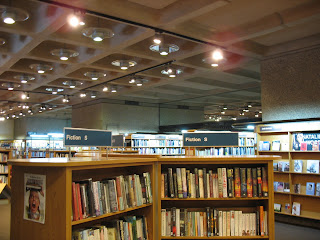 Our last trip as a class was to the Maughan Library and ISC at the Strand Campus of King's College. The building was previously used by as the Public Record Office. When it became vacant in the late 1990's, King's College elected to consolidate 4 separate libraries into 1. Since the building was built to house public records in 1851, it was designed to be fireproof, a perfect match for a library. One hurdle the college had to deal with is the fact that this is a Listed Building and very few, if any, structural modification could be made. However, another benefit of the previous purpose is that the building was designed to bear the weight of papers and documents, so load bearing has not been a concern for the Library.
Our last trip as a class was to the Maughan Library and ISC at the Strand Campus of King's College. The building was previously used by as the Public Record Office. When it became vacant in the late 1990's, King's College elected to consolidate 4 separate libraries into 1. Since the building was built to house public records in 1851, it was designed to be fireproof, a perfect match for a library. One hurdle the college had to deal with is the fact that this is a Listed Building and very few, if any, structural modification could be made. However, another benefit of the previous purpose is that the building was designed to bear the weight of papers and documents, so load bearing has not been a concern for the Library.The current collection consists of 3-4 million volumes and covers numerous topics, such as American studies, Byzantine & modern Greek, digital culture & technology, European studies, film studies, history, linguistics, theology & religious studies, war studies, law, engineering, mathematics and physics. The Library is available to anyone with serious research plans. There are approximately 11,000 students at the Strand campus and 20,000 students city-wide.
The building is a nice mix of the old and new. Due to the restrictions by the English Heritage, the architects had no choice but to leave the historical integrity of the space. However, they succeeded in bringing the facility into the 21st century with modern amenities.










































